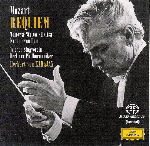It’s difficult to comprehend the A&R decision to release this particular version of Mozart’s Requiem–the second of three commercially recorded versions Herbert von Karajan made for DG–to inaugurate Universal’s foray into the world of SACD. Its 1975 analogue sound is unimpressive, and even with the help of a newly mastered 96 kHz/ 24-bit source (transcoded into DSD for SACD playback), this is not exactly demonstration-quality material to show off SACD’s supposed virtues. Moreover, with this release, there are now four currently available recordings of this performance in some digital format. Why Universal did not choose to re-release Karajan’s highly-regarded large-scale 1987 digital recording begs the question of whether in some cases Universal merely has jumped on the SACD bandwagon for the ability to renew licenses of older catalog items (and possibly prevent pirating of higher-resolution material). In this respect, Karajan’s inferior 1962 recording had no chance, considering it was recently re-issued in the “DG Originals” imprint. But it is useless to speculate, so on to the music.
As might be expected, Karajan takes a romantic, magisterial view of the Requiem; the interpretation is decidedly weighty with slowish tempos, long legato lines in the strings, and a hell-bent chorus that rarely dips below mezzo-forte and sometimes borders on sounding overbearing. All of the soloists are excellent and well-balanced, sharing the same timbral heaviness that characterizes the rest of the forces. And, while this sort of interpretation is valid, it now sounds somewhat out of step with the times, given all the “period”-style recordings that have flooded the market over the years.
The newly mastered hybrid SACD version (remixed specially for both stereo and multi-channel) benefits from the aforementioned upsampling, offering a much cleaner, open sound and curing some harshness in the upper strings that was evident in the CD version (the DG Galleria CD was used for comparison). The multi-channel mix delivers uneven results, but at least DG made an attempt to do something other than stream the data indifferently through all five speakers. In this case, at least the soloists are set firmly in the front three channels (probably electronically omitted from the rears); the orchestra and chorus, however, remain in full force throughout the main speakers (except the subwoofer), thus imbuing the sonic picture with a simulated 360-degree quality that puts the listener (once again) squarely in the orchestra. The effect is certainly involving but completely unnatural, self-defeating, and ultimately annoying. But, since you get SACD stereo, SACD surround, and CD stereo all in one package, you can still admire the effort (and value) that went into this re-release, as unusual and ungainly a choice it may have been.
































